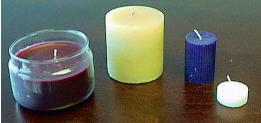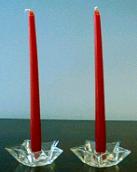CPSC Votes to Begin Rulemaking to Ban Candles With Lead Wicks
NEWS from CPSC
U.S. Consumer Product Safety Commission
| Office of Information and Public Affairs |
Washington, DC 20207 |
FOR IMMEDIATE RELEASE
February 14, 2001
Release # 01-083
|
CPSC Consumer Hotline: (800) 638-2772
CPSC Media Contact: Scott Wolfson, (301) 504-7051
|
CPSC Votes to Begin Rulemaking to Ban Candles With Lead Wicks
Major Retailers Agree to Not Sell Lead Wick Candles
WASHINGTON, D.C. - The U.S. Consumer Product Safety Commission (CPSC) voted to begin rulemaking that could lead to a ban on candles with lead-core wicks. CPSC has determined that candles using lead wicks could present a lead poisoning hazard to young children.
Studies have found that despite a voluntary industry agreement in the past to remove lead from candle wicks, a small percentage of candles sold today still contains lead in their wicks. The lead cores are used to hold the wicks upright as they burn. The study found that lead-core wicks could emit relatively large amounts of lead into the air during burning. The emitted lead presents a risk to children from exposure through inhalation and from ingestion of lead that may settle on surfaces in the room. This deposited lead could remain accessible to a child for an extended period of time and allow exposure through direct mouthing of surfaces or objects or by hand-to-mouth contact.
Some of the candles emitted lead levels in excess of 2,200 micrograms per hour - about five times the rate that could lead to elevated levels of lead in a child. CPSC estimates that a level of 430 micrograms per hour could result in hazardous exposure to children.
The CPSC found that burning a candle with a lead wick for four hours per day, for 15 to 30 days, could result in blood lead levels above the 10 micrograms per deciliter that is considered a health concern for young children.
Lead poisoning in children is associated with behavioral problems, learning disabilities, hearing problems and growth retardation. Because lead accumulates in the body, even exposure to small amounts of lead can contribute to the overall level of lead in the blood. It is estimated that approximately 1 in every 25 children under the age of 6 in the United States has elevated levels of lead in their blood; that is almost one million children nationwide. The primary source of lead poisoning in the United States is lead from paint in old homes.
It is not possible for consumers to tell if the wicks of candles they are using contain lead. CPSC analysis shows that metal wicks, some of which could contain lead, are most likely to be used in container, pillar, votive and tealight candles.
Tapers, commonly used as dinner candles, use cotton wicks and do not contain lead.
To check a candle in your home, look at the top of the wick. If there is metal, you will see it in the center of the wick. If you have young children, do not burn candles with metal wicks or throw them away.
Rulemaking to set a federal ban would not go into effect before the end of the year. Many retailers currently are not selling candles with lead wicks, including:
- Pier 1
- Gap
- Wal-Mart
- Michaels Stores
- Winn-Dixie
- Frank's Nursery & Crafts
- Ahold/USA, parent of Stop & Shop, Giant, Tops and Peapod
- Blyth, parent of PartyLite
- Bullfrog Light Company
- Atlanta Candle Factory
- Mom's Kitchen Candles
CPSC encourages other retailers to take steps and advise consumers of their efforts to keep candles with lead wicks off store shelves. Consumers should ask stores not specifically listed whether their candles have lead free wicks.
In addition to the list above, CPSC is providing a list of National Candle Association (NCA) members and Non-NCA members that have made a "no-lead wick pledge."
Safe alternatives to lead wicks, including zinc, tin, synthetic fibers, cotton and paper, are readily available to manufacturers.
A federal ban would apply to all domestic and imported candles. It would deter manufacturers from making non-conforming wicks, allow the U.S. Customs Service to stop shipments of non-conforming candles, and make it easier for the CPSC to seek penalties against companies for violations.
Chairman Ann Brown and Commissioner Thomas Moore voted to begin rulemaking, Commissioner Mary Sheila Gall voted to grant the petition but to refer it to the Office of Management and Budget for review. The statements of Chairman Brown and Commissioners Moore and Gall are available below or by calling the Office of the Secretary at (301) 504-7923.
 Consumers can also
view a video clip about lead wick candles (transcript). This is in "streaming video" format.
Consumers can also
view a video clip about lead wick candles (transcript). This is in "streaming video" format.
Statement of the Honorable Ann Brown In Support of Petition and Advance
Notice of Proposed Rulemaking To Ban Lead-Cored Candle Wicks
February 13, 2001
I voted today to grant petitions submitted to the Commission, and to issue an Advance Notice of Proposed Rulemaking (ANPR), to ban candlewicks containing lead, and candles containing such wicks. Protecting children from dangers like lead in candlewicks is what Congress created CPSC to do.
With respect to the White House request that CPSC submit its regulations to OMB for review and approval until new leadership is appointed at CPSC, Congress specified that it wanted CPSC removed as far as possible from the influence of partisan politics or political control. Influence in the form of oversight by OMB or a change in political leadership was what Congress wanted CPSC to avoid. Congress told the CPSC to protect consumers from dangerous products - to protect children from the behavioral problems and learning disabilities associated with lead. That is what we are voting today to do.
Statement of the Honorable Thomas H. Moore in Support of Granting the Petition
to Ban Lead-Cored Candle Wicks and Issuing an Advance Notice of Proposed Rulemaking
February 9, 2001
Rather than restate what she has expressed so ably, I simply will agree with Commissioner Gall's reasoning for issuing an advance notice of proposed rulemaking to ban the use of lead in cored candle wicks.
I can not concur, however, on sending the ANPR to the Office of Management and Budget for their review to determine if it impacts "critical health and safety functions of the
agency ...." While I believe that we must give any President due deference when he makes a request of us, I do not think that the Consumer Product Safety Commission, an independent agency,
can comply with this request without seriously eroding the power granted by Congress to the individual Commissioners. We would certainly hope that this (and any of our proposed regulations)
would fit under a safety exception, but there is no guarantee that OMB would agree with us. If they did not, the memorandum from the President's Chief of Staff would require that the
proposed regulation be held up until a new agency head appointed by President Bush "reviews and approves the regulatory action."
The Consumer Product Safety Commission is not governed by a single administrator. The Chairman of this Commission does not have the authority to review and approve proposed or final regulatory actions. In this regard, the Chairman is like any other commissioner and has one vote as to whether to proceed on a particular matter. I, for one, would not want to delegate my vote on whether to proceed with a regulation to any Chairman, no matter how much I might agree in general with that Chairman's philosophy.
Nor do I think it would be wise from a policy standpoint to give any power over the promulgation of our regulations, even on a temporary basis, to an office of the Executive Branch, in this case the OMB. The Congress, not the President, delegates the powers of independent agencies to them. As such the Congress is the Consumer Product Safety Commission's true steward and we must be ever mindful of not subjugating the powers Congress has given us to a review by the Executive Branch that was never intended.
Statement of the Honorable Mary Sheila Gall In Support of Granting of Petition
and Issuing an Advance Notice of Proposed Rulemaking to Ban Use of Lead-Cored Candle Wicks
February 9, 2001
I voted today to grant a petition submitted to the Commission and to issue an Advance Notice of Proposed Rulemaking (ANPR) to ban lead-cored candlewicks. The deleterious health effects of exposure to lead are well known and documented. While it appears that no specific case of lead poisoning can be tied to exposure to candle fumes, exposure to such fumes is cumulative with other sources of lead exposure. Moreover, exposure to lead from burning candlewicks is through inhalation, and not just ingestion, a mechanism with which many consumers may not be familiar.
Other factors incline me to begin rulemaking in this case. The hazard cannot be avoided by labeling, since the only way to avoid the hazard is to forego burning, the intended use of the product. Nor is there any "home test" by which consumers can determine accurately whether candles have lead-cored wicks. Sophisticated laboratory tests conducted by Commission staff have shown that there is no correlation between the amount of lead in the candlewick and the quantity of lead emissions produced when that candle is burned. A ban, therefore, may be the only mechanism to eliminate this hazard.
The Federal Hazardous Substances Act directs the Commission to defer to voluntary standards where the standard would eliminate or adequately reduce the risk of injury, and where it is likely that there will be substantial compliance with the voluntary standard. There has been a voluntary agreement since 1974 among candle makers in the United States not to use lead wicks in candles. Investigation by the Commission staff has shown that importers of candles have not followed this voluntary agreement, nor has it been followed universally by manufacturers within the United States. The Commission will, during the course of rulemaking, evaluate whether some other voluntary standard could meet the statutory criteria of hazard reduction and substantial compliance.
I also voted to submit the ANPR to the Office of Management and Budget (OMB) prior to sending it to the Office of the Federal Register (OFR) for publication. On January 20, 2001 a memorandum entitled "Regulatory Review Plan" was transmitted to the Heads and Acting Heads of Executive Departments and Agencies on behalf of the President. This memorandum, inter alia, directed executive branch agencies to refrain temporarily from transmitting proposed or final regulations to the OFR. The memorandum permitted agencies to request an exception from OMB in the case of regulations that impact critical health and safety functions of the agency. It encouraged independent agencies, such as the Commission to participate voluntarily in this review.
I recognize that the Commission is not required to submit this ANPR to OMB prior to transmitting it to the OFR. But there is no prohibition against the Commission cooperating voluntarily with the President's memorandum. The Commission already voluntarily performs actions set forth in executive orders that it is not required to perform, such as the preparation of a regulatory agenda. The actions requested by the January 20 memorandum are less burdensome than the preparation of a regulatory agenda, and are, by the express terms of the memorandum, temporary. Moreover, I am certain that OMB will agree that the exception for critical health and safety functions of the Commission will apply to this ANPR and will acquiesce in its publication in the Federal Register. Submitting the ANPR to OMB and requesting an exception does not constitute review and approval of the substance of the ANPR; it requires only a determination that it "impacts critical health and safety functions" of the Commission. Thus, the voluntary cooperation by the Commission with the January 20 memo will not undermine or compromise the Commission's independence.


